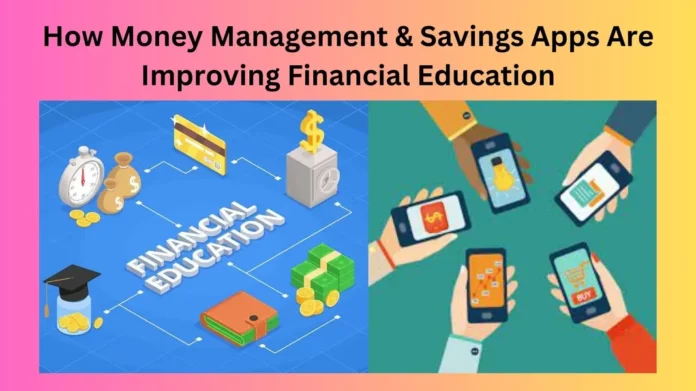In a world where financial literacy is the key to unlocking economic well-being, the role of technology in shaping our financial habits cannot be overstated. With the advent of innovative money management and savings apps, individuals now have powerful tools at their fingertips to gain better control over their finances. This article delves into the transformative impact of these apps on financial education, exploring how they have become essential companions in the journey towards fiscal responsibility.
1. The Rise of Money Management Apps
In recent years, the financial landscape has witnessed a surge in the popularity of money management apps. These digital companions have made it easier than ever for individuals to track their spending, set budgets, and gain insights into their financial habits. Gone are the days of manual bookkeeping; these apps offer real-time data that empowers users to make informed financial decisions.
2. Demystifying Budgeting with User-Friendly Interfaces
One of the standout features of these apps is their user-friendly interfaces that demystify the often-daunting task of budgeting. With intuitive design and simple navigation, users can effortlessly categorize their expenses, set savings goals, and monitor their progress. The shift from complex spreadsheets to visually appealing dashboards has made budgeting more accessible to users across different age groups and financial literacy levels.
3. Gamification of Savings
Savings apps are taking a page from the world of gaming to make the process of saving money more engaging. Through gamification, users are incentivized to save by turning the act of budgeting and putting money aside into a rewarding experience. Achievements, badges, and friendly competitions with friends on savings goals are just a few ways these apps are making financial responsibility a fun and motivating journey.
4. Nudging Towards Financial Wellness
Beyond the mere tracking of expenses, many money management apps go the extra mile by providing personalized financial advice. Through gentle nudges and reminders, users are prompted to make better financial choices. Whether it’s suggesting ways to cut unnecessary expenses or recommending investment opportunities, these apps act as virtual financial advisors, fostering financial wellness among their users.
5. The Educational Power of Simulations
To enhance financial education, some apps incorporate simulations that allow users to experiment with different financial scenarios. By simulating the impact of various decisions on their budget, users can develop a deeper understanding of the cause-and-effect relationship between their choices and financial outcomes. This hands-on approach to learning transforms these apps into virtual classrooms for financial education.
6. Fostering Responsible Credit Management
Credit management is a crucial aspect of financial education often overlooked. Money management apps, however, are stepping in to fill this gap. Users can monitor their credit scores, receive alerts for potential issues, and access resources that educate them on responsible credit practices. This proactive approach to credit education helps users build and maintain healthy credit profiles.
7. Collaboration and Shared Finances
In an era of shared responsibilities, many money management apps recognize the need for collaboration. Couples, families, and friends can use these apps to manage shared expenses, set joint goals, and ensure transparent communication about their financial matters. This collaborative feature not only promotes financial transparency but also fosters healthy financial discussions within relationships.
8. The Accessibility Revolution
The impact of money management and savings apps on financial education goes beyond individual users. These tools are playing a pivotal role in making financial information and resources more accessible to underserved communities. With many apps available for free or at affordable prices, individuals who might not have had access to traditional financial education now have a pathway to empowerment.
9. Challenges and Security Concerns
While the benefits of money management apps are clear, it’s essential to address the challenges and security concerns associated with these tools. From data breaches to potential misuse, users need to be aware of the risks and take necessary precautions to safeguard their financial information. Choosing reputable apps with robust security measures is crucial for a positive experience.
10. The Future of Financial Education
As technology continues to advance, the future of financial education appears promising. Money management and savings apps are likely to evolve, incorporating artificial intelligence and machine learning to provide even more personalized and effective financial guidance. The ongoing integration of these technologies will further enhance the user experience and contribute to a more financially literate society.
Conclusion:
In conclusion, the marriage of technology and financial education through money management and savings apps is reshaping the way individuals interact with their finances. From simplifying budgeting to fostering collaborative financial discussions, these apps are catalysts for positive change. As we embrace the digital era, it is clear that these tools are not just apps; they are empowering individuals to take control of their financial destinies.
FAQs:
1. Are money management apps safe to use?
Yes, reputable money management apps prioritize the security of user data. However, users should be cautious and choose apps with robust security measures to protect their financial information.
2. Can these apps really improve financial education?
Absolutely. Money management apps provide practical, real-time insights, simulations, and personalized advice that contribute significantly to financial education.
3. How do savings apps incorporate gamification?
Savings apps use gamification elements like badges, achievements, and friendly competitions to make the act of saving money more engaging and enjoyable.
4. Are these apps suitable for all age groups?
Yes, the user-friendly interfaces of money management apps make them suitable for users of all age groups, regardless of their level of financial literacy.
5. Can money management apps help with long-term financial planning?
Yes, many apps offer features that assist users in setting and achieving long-term financial goals, contributing to a more secure financial future.















